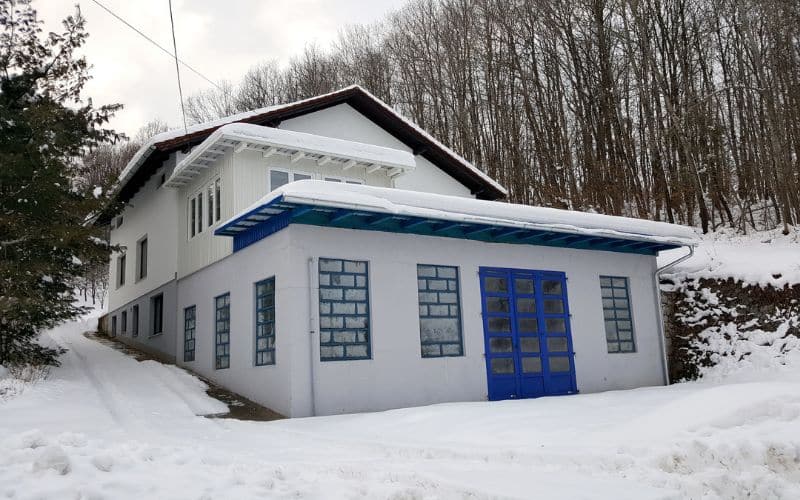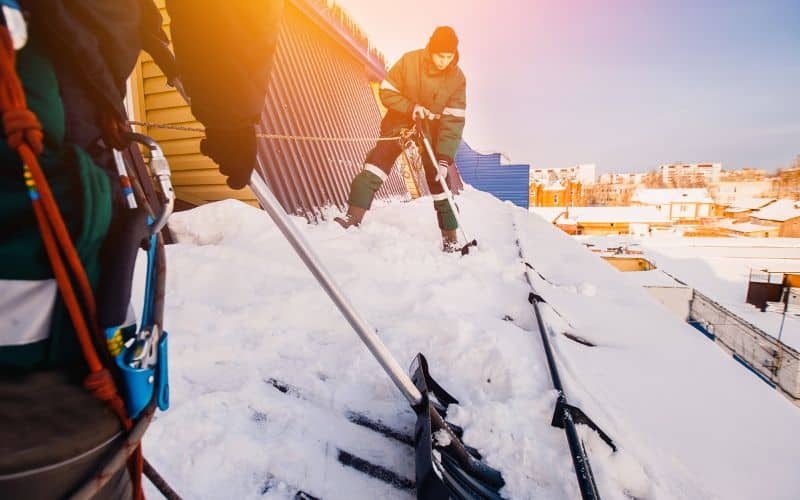
As winter wraps its icy fingers around your home, the threat of snow and ice looms large, bringing potential water leaks and damage in its wake. Living in cold regions, like the Midwest, means being proactive about protecting your home from these frosty hazards. In this article, you’ll discover practical steps to shield your abode from the relentless onslaught of winter weather.
Understanding the risks of unchecked snow accumulation on your roof is crucial. You’ll learn the safest ways to clear away the snow without causing harm to your property—or yourself. Whether you’re reaching for a roof rake or considering professional help, you’ll find the guidance you need to tackle the task with confidence.
Stay tuned as we delve into strategies for safeguarding your home against the perils of winter, ensuring you’re well-prepared for whatever the season throws your way.
Assessing the Risks
Understanding the Impact of Snow on Your Home
When winter arrives, your home faces the significant weight of snow accumulation which can pose a threat to your roof’s structure. The average weight of a cubic foot of snow can range from 7 pounds for light, fluffy snow to 20 pounds for wet, heavy snow. Houses in regions known for heavy snowfall are designed to withstand this pressure to a certain extent, but it’s critical to understand when the snow load exceeds safety margins.
The impact of snow isn’t just about weight; temperature fluctuations can cause snow to melt and refreeze, resulting in ice dams that prevent proper drainage and can lead to water seeping under your shingles, damaging your roof and internal structures.
Identifying Vulnerable Areas
Certain areas of your home are more susceptible to snow and ice damage, and it’s essential to identify and monitor them:
- Roof and Gutters: Keep an eye on the formation of ice dams at the edge of your roof, which can result in costly leaks. Ensure your gutters are clear of debris to facilitate proper melting snow flow.
- Trees and Branches: Heavy snowfall can break tree limbs, threatening your safety and potentially damaging your roof, windows, and cars. Regularly trim trees and remove dead branches to prevent accidents.
- Building Envelope: Inspect windows, doors, and foundational walls for weaknesses where melting snow can penetrate, leading to potential flooding.
By staying vigilant and recognizing these vulnerable spots, you’re better prepared to take preemptive action against the destructive capabilities of winter weather. Keep your roof clear of excess snow build-up, maintain clean gutters, and monitor tree health to safeguard your home.
Preparing Your Home
As the winter months loom, ensuring your house can withstand the season’s challenges involves careful preparation across several fronts. Here’s a rundown of critical tasks to secure your home against snow damage.
Inspecting Your Roof
Your roof bears the brunt of winter weather. To mitigate potential issues:
- Assess its structural integrity before the onset of winter. A compromised structure increases the risk of collapse under heavy snow.
- Watch for signs of wear, such as cracked or missing shingles, which can lead to leaks and water damage.
- Assess the attic for daylight peeking through which signals possible breaches.
- Ensure metal components like flashing are firmly secured, as they play a crucial role in waterproofing.
Checking your roof is about prevention – detecting small problems before they demand expensive repairs.
Ensuring Proper Insulation
Proper insulation is a multipurpose guardian for your home:
- It conserves energy by maintaining warmth, reducing your heating bills as a result.
- It prevents heat from escaping to the attic, deterring ice dam formation.
- Enhance insulation in walls and the attic to establish a thermal barrier against harsh temperatures.
- Install weather stripping around doors and windows to bolster insulation, saving energy and money.
Upgrading insulation isn’t just a comfort measure; it’s a financial safeguard improving the longevity of your heating systems and the overall energy efficiency of your home.
Clearing Gutters and Downspouts
Clear gutters and downspouts are crucial for:
- Facilitating the proper drainage of melting snow and ice; clogged systems can result in water backing up, causing damage to your roof and walls.
- Preventing ice dams which are not just a nuisance but also a genuine threat to your roofing structure.
- Inspecting and cleaning gutters in autumn ensures they’re ready for winter’s precipitation.
- Consider installing gutter guards to minimize debris accumulation, ensuring a smoother flow of water.
Regular maintenance of gutters and downspouts is essential. They play a critical role in your home’s defence mechanism against snow-related damage.

Snow Removal Techniques
Protecting your house from the ravages of winter necessitates effective snow removal techniques. Knowing the right method to use can save you time, prevent damage to your property, and even reduce the risk of personal injury.
Shoveling Snow
Shoveling is the most traditional way to clear snow. When you’re doing it yourself, you’re in control of the pace and the careful handling of delicate areas around your house. To maximise efficiency and safety:
- Choose the right shovel. Ergonomic designs reduce strain on your back.
- Start early and go often. Light, fluffy snow is easier to remove before it compacts.
- Clear a path to all exits for safety in case of an emergency.
- Don’t forget to clear snow from ventilation outlets to avoid carbon monoxide build-up.
Using a Snow Blower
A snow blower can drastically reduce the time and effort you spend on snow removal:
- Ideal for larger driveways or open spaces.
- Can handle heavier snowfall without the backbreaking work.
- Remember to service your snow blower before winter hits to ensure it’s ready to use.
Important: Always follow the manufacturer’s guidelines to operate the equipment safely and store fuel correctly – away from any sources of heat or flame.
Hiring Professionals
For those who are unable or prefer not to tackle snow removal themselves, hiring professionals is a viable option:
- They have the expertise to remove snow quickly and efficiently from roofs and other structures.
- Pros have specialized equipment to deal with compact ice and prevent damage to your property.
Important: Always check the credentials and reviews of any professional service you’re considering. They must be insured to shield you from liability in the event of an accident or property damage.
Remember, while you’re focused on snow removal, it’s equally important to consider the subsequent management of meltwater. Proper drainage solutions should be in place to prevent water seepage into your home. Keep an eye out for warning signs of water damage as the snow starts to thaw.
Preventing Ice Dams
As the mercury dips, it’s vital to safeguard your home against ice dams. These ridges of ice can cause significant damage, but with the right measures, you can prevent them from forming on your roof.
Installing Heat Cables
Installing heat cables is one proactive step to prevent the formulation of ice dams. These cables create channels for melted snow to flow off the roof, circumventing water buildup that can penetrate your home. Here’s what you need to know:
- Heat cables should be installed along the roof edge where ice dams typically form.
- It’s essential to attach them in a zigzag pattern to ensure comprehensive coverage of areas prone to icing.
- Thermostatically controlled heat cables are ideal, especially if your roof is made of sensitive materials, as they can be regulated to work only when necessary.
- Always follow the manufacturer’s instructions to ensure optimal performance and safety.
Adding Insulation to Your Attic
Boosting insulation in your attic isn’t just about comfort; it’s a critical defensive strategy against ice dams. Subpar insulation allows heat to escape, contributing to ice dam formation.
The benefits of adequate attic insulation include:
- Reduced heat transfer from the living space to the attic.
- A significant drop in the possibility of snow melting unevenly on the roof and refreezing at the edges.
- Enhanced overall energy efficiency, which can lead to lowered heating bills.
Ensure that the attic floor is well-insulated, aiming for an R-value that aligns with your specific geographic region’s recommendations.
Improving Ventilation
Good attic ventilation prevents heat buildup beneath the roof surface—a key factor in the creation of ice dams. Here are the steps you should take:
- Keep the attic well-ventilated to maintain a temperature close to that of the outside air.
- Install ridge and soffit vents to enable continuous air movement.
- Ensure that any existing vents are not obstructed by insulation or other debris.
Proper ventilation not only prevents ice dams but also extends the life of your roof by averting moisture accumulation that can lead to rot and mold.
By implementing these strategies, you’re on your way to fortifying your home against the ravages of winter, keeping it protected from intrusive ice and water damage.
Protecting Exterior Elements
When it comes to shielding your home from the ravages of snow, the exterior elements require your utmost attention. It’s crucial to prepare these outdoor fixtures to ensure they withstand the harsh conditions winter presents.
Applying Anti-Icing Agents
To prevent ice from gripping steps and walkways, making them treacherous, you’ll need to apply anti-icing agents. Ice-repellent solutions are perfect for this task. They work by lowering the freezing point of water, which prevents ice from forming. For best results, spray these agents before the onslaught of freezing weather. Not only do they keep ice at bay, but they also ensure a safer passage around your home.
Protecting Plants and Trees
Your garden is equally at risk during winter. To safeguard it from frost damage, bring container plants indoors and add a layer of mulch around the base of plants to act as insulation. Covering sensitive plants with burlap or plant covers can prevent frostbite, but remember to remove these covers when temperatures rise to prevent overheating. If snow accumulates on plants and shrubs, brush it off gently in an upward motion to avoid breaking branches.
Securing Outdoor Furniture and Equipment
Outdoor furniture and equipment can suffer damage if left unprotected. Secure or store any items that could be damaged by snow and ice. Covering with waterproof tarps can shield against moisture, while storing items like grills or bicycles indoors will protect them from the elements. For items that remain outdoors, ensure they’re anchored to prevent them from being blown away or toppled by strong winter winds.
Conclusion
Protecting your home from snow is crucial for maintaining its integrity and your comfort during the winter months. By implementing the strategies you’ve learned, you’ll not only safeguard your property but also enhance its energy efficiency. Remember, it’s about being proactive rather than reactive to the whims of winter weather. Stay warm and secure, knowing you’ve taken the right steps to shield your house from the harsh elements. Now, you’re all set to enjoy the snowy season without the worry of home damage.
Colin Macmillan is a seasoned entrepreneur and the CEO of Riverwood Landscape, a leading landscaping company based in Canada. He has been at the helm of the company since leaving high school, demonstrating his strong leadership skills and business acumen.
Colin’s expertise lies in various aspects of landscaping, including lawn care, interlocking, sod installation, and commercial maintenance. His hands-on approach and dedication to the craft have been instrumental in building Riverwood Landscape into a reputable brand.
One of his most notable achievements is the creation of a successful landscape franchise that services multiple locations. This accomplishment underscores his strategic thinking and ability to scale operations effectively.
Colin has also had the privilege of working with Guelph Hospital for landscaping and maintenance, a testament to the trust and reliability that his company has earned over the years.
His professional mission is to offer the best services and experiences for customers, a goal that he tirelessly pursues. Colin’s commitment to excellence and customer satisfaction continues to drive the growth and success of Riverwood Landscape.









